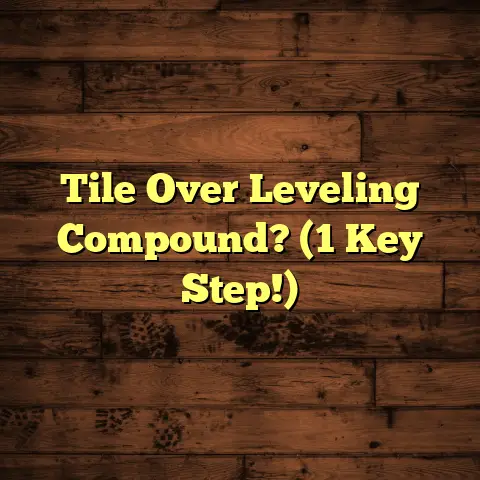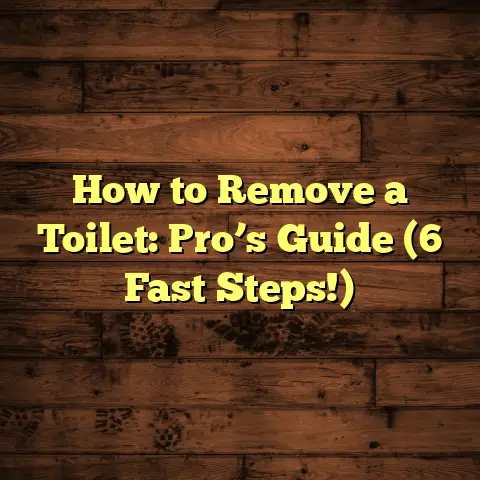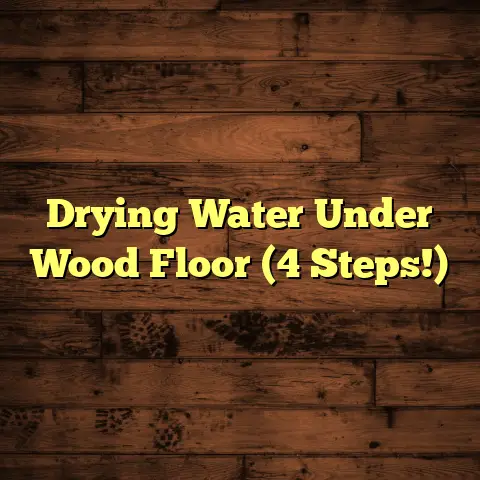How To Plug Floor Hole? (7 Min Quick Fix!)
Let’s talk about something that can really bug a homeowner: floor holes.
I’m talking about those little (or not-so-little) blemishes that pop up and threaten to ruin your otherwise perfect space.
I get it.
You want a clean, safe home.
A place where
you can walk around barefoot without worrying about
stubbing a toe or, worse, tripping.
Holes in your
flooring are not only unsightly, but they can also
lead to bigger problems down the road.
Think about it: moisture seeping in, pests making a
home, or even structural damage.
Nobody wants that!
Now, before you start thinking about ripping up your
entire floor, let me tell you: there’s hope!
I’m going
to walk you through a super quick and effective method
to plug those pesky holes, often in as little as 7
minutes.
Yes, you read that right!
But first, let’s chat about prevention.
I’m a big
believer in taking steps to avoid problems in the first
place.
That’s why I always recommend considering
low-maintenance flooring options.
These are the unsung heroes that can minimize damage
and reduce the chances of holes appearing.
We’re
talking vinyl, laminate, and tile – materials known for
their durability and ease of upkeep.
They’re tough
cookies!
So, are you ready to dive in and learn how to banish
those floor holes for good?
Let’s do this!
1. Understanding Floor Holes
Alright, before we grab our tools and get our hands
dirty, let’s get a little background info.
Knowing
what you’re dealing with is half the battle, right?
1.1 Types of Flooring
First off, let’s quickly run through some common flooring types:
- Hardwood: The classic, elegant choice. Adds value to your home but can be susceptible to scratches and dents.
- Laminate: A budget-friendly alternative to hardwood. Durable and easy to clean, but not as water-resistant.
- Tile: Perfect for bathrooms and kitchens. Super durable and water-resistant, but can be cold underfoot.
- Carpet: Soft and cozy, but can trap dirt and stains. Needs regular cleaning.
Each of these materials reacts differently to wear and
tear.
Hardwood might get dented by heavy furniture,
laminate can chip, tile can crack, and carpet can get
worn down in high-traffic areas.
1.2 Common Causes of Floor Holes
So, what exactly causes these annoying holes to appear? Here’s the lowdown:
- Natural wear and tear: Over time, all flooring will show some signs of aging. High-traffic areas are especially prone to wear.
- Accidental damage: Dropping something heavy, dragging furniture, or even just a clumsy step can cause a hole. I’ve seen it all!
- Moisture and water-related issues: Water damage can weaken flooring materials, making them more susceptible to holes. This is especially true for wood and laminate.
- Pest infestations: Termites, carpenter ants, and other pests can literally eat away at your flooring, leaving behind holes and tunnels.
Example:
I once had a client who couldn’t figure out why their
hardwood floor was suddenly developing small holes.
Turns out, they had a termite infestation!
We had to
call in the exterminators before we could even think
about repairing the floor.
Understanding the cause of the hole is important
because it can help you prevent future problems.
If
it’s water damage, you need to fix the leak.
If it’s
pests, you need to call in the pros.
2. Tools and Materials Needed for the Quick Fix
Okay, now for the fun part: gathering our supplies!
Having the right tools and materials on hand will make
this quick fix even quicker.
Trust me, you don’t want
to be running to the hardware store mid-project.
2.1 Essential Tools
Here’s what you’ll need in your toolbox:
- Putty knife: For applying and smoothing filler. Get a good quality one with a flexible blade.
- Sandpaper: For smoothing out the repaired area. You’ll want a few different grits, from coarse to fine.
- Utility knife: For trimming excess material. Make sure you have a sharp blade for clean cuts.
- Measuring tape: For measuring the size of the hole and the patch material.
- Vacuum cleaner: For cleaning up dust and debris. A shop vac is ideal, but a regular vacuum will work in a pinch.
2.2 Recommended Materials
The materials you’ll need will depend on the type of
flooring you’re repairing.
Here’s a breakdown:
- Hardwood Floors: Wood filler is your best friend here. Look for a color that closely matches your flooring. Epoxy resin can also be used for larger or more damaged areas.
- Laminate Floors: Laminate repair kits are specifically designed for this type of flooring. They usually include a color-matching putty and applicator.
- Tile Floors: Epoxy resin or grout can be used to fill gaps in tile. Choose a color that matches your existing grout.
- Carpet Floors: Carpet patching kits are the way to go. These kits include a piece of carpet that you can cut to size and glue into place.
Important Note: Always read and follow the
manufacturer’s instructions for any materials you use.
This will ensure the best results and prevent any
unforeseen problems.
Here’s a quick table to summarize the materials:
3. Step-by-Step Guide to Plugging Floor Holes
Alright, let’s get down to business!
This is where we
actually plug those pesky holes.
I’m going to break it
down by flooring type, so you can easily follow along.
3.1 Preparing the Area
No matter what type of flooring you’re working with, the first step is always the same: clean the area around the hole.
- Vacuum up any loose dust and debris. You want a clean surface for the filler or patch to adhere to.
- Wipe down the area with a damp cloth. This will remove any remaining dirt or grime.
- Let the area dry completely. Moisture can interfere with the adhesion of the filler or patch.
3.2 Choosing the Right Method
Now, let’s get specific. Here’s how to tackle holes in different types of flooring:
3.2.1 Hardwood Floors
Hardwood floors are beautiful, but they can be prone to
dents and holes.
Here’s how to fix them:
- Choose your filler: For small holes, wood filler is usually sufficient. For larger or more damaged areas, epoxy resin is a better choice.
- Prepare the filler: If you’re using wood filler, follow the manufacturer’s instructions for mixing. You want a consistency that’s similar to peanut butter. Epoxy resin usually comes in two parts that need to be mixed together.
- Apply the filler: Use a putty knife to apply the filler to the hole. Overfill the hole slightly, as the filler will shrink as it dries.
- Smooth the filler: Use the putty knife to smooth the filler, making it flush with the surrounding floor.
- Let the filler dry: Follow the manufacturer’s instructions for drying time. This can range from a few hours to overnight.
- Sand the filler: Once the filler is dry, use sandpaper to smooth it down and blend it with the surrounding floor. Start with a coarse grit and then move to a finer grit.
- Stain or paint the filler: If necessary, stain or paint the filler to match the color of your flooring.
Tip: For a more seamless repair, try mixing some
sawdust from your flooring with the wood filler.
This
will help the filler blend in better.
3.2.2 Laminate Floors
Laminate floors are a bit trickier to repair than
hardwood floors, but it’s still doable.
Here’s how:
- Purchase a laminate repair kit: These kits usually include a color-matching putty and applicator. You can find them at most hardware stores.
- Clean the area: As with all flooring types, start by cleaning the area around the hole.
- Apply the putty: Use the applicator to apply the putty to the hole. Overfill the hole slightly.
- Smooth the putty: Use the applicator to smooth the putty, making it flush with the surrounding floor.
- Let the putty dry: Follow the manufacturer’s instructions for drying time.
- Clean up any excess putty: Use a damp cloth to wipe away any excess putty from the surrounding floor.
Important Note: Laminate repairs are often visible,
so don’t expect a perfect match.
However, a good repair
kit can make the hole much less noticeable.
3.2.3 Tile Floors
Cracked or chipped tiles can be an eyesore. Here’s how to fix them:
- Remove any loose pieces of tile: Use a utility knife to carefully remove any loose pieces of tile from the hole.
- Clean the area: Vacuum up any dust and debris.
- Apply epoxy resin or grout: If the hole is small, you can use grout to fill it. For larger holes, epoxy resin is a better choice. Follow the manufacturer’s instructions for mixing and application.
- Smooth the filler: Use a putty knife to smooth the filler, making it flush with the surrounding tile.
- Let the filler dry: Follow the manufacturer’s instructions for drying time.
- Clean up any excess filler: Use a damp cloth to wipe away any excess filler from the surrounding tile.
Tip: If you’re using grout, you can use a grout sponge to smooth the surface and remove any excess grout.
3.2.4 Carpet Floors
Carpet holes can be tricky to repair, but a carpet
patch can work wonders.
Here’s the method:
- Find a matching piece of carpet: Ideally, you’ll have a spare piece of carpet from the original installation. If not, you can try to find a close match at a carpet store. You can also steal a piece from a closet or under furniture.
- Cut the patch to size: Use a utility knife to cut the patch to the same size and shape as the hole.
- Apply carpet adhesive: Apply carpet adhesive to the back of the patch.
- Place the patch in the hole: Carefully place the patch in the hole, making sure it’s aligned with the surrounding carpet.
- Press down firmly: Press down firmly on the patch to ensure it adheres to the floor.
- Let the adhesive dry: Follow the manufacturer’s instructions for drying time.
Pro Tip: Use double-sided carpet tape for a less
permanent fix.
This is great for small holes or if you
think you might need to replace the patch in the future.
3.3 Application Process
No matter which method you’re using, the key to a
successful repair is to take your time and follow the
instructions carefully.
Don’t rush the process, and
don’t be afraid to ask for help if you’re unsure about
something.
Remember: Smoothing and blending the repair with
the existing flooring is crucial.
The goal is to make
the repair as invisible as possible.
4. Finishing Touches
You’ve plugged the hole!
Now it’s time for the
finishing touches that will make your repair look
professional.
4.1 Curing and Drying
The curing and drying time for fillers and adhesives
varies depending on the product.
Always check the
manufacturer’s instructions for specific details.
- Wood filler: Typically dries in a few hours to overnight. Avoid walking on the repaired area until the filler is completely dry.
- Epoxy resin: Can take 24-72 hours to fully cure. Avoid putting any weight on the repaired area during this time.
- Laminate repair putty: Usually dries in a few hours.
- Grout: Can take 24-72 hours to fully cure. Keep the area dry during this time.
- Carpet adhesive: Typically dries in 24 hours. Avoid walking on the repaired area during this time.
4.2 Final Inspection
Once the filler or adhesive is dry, it’s time for a final inspection.
- Check for levelness: Make sure the repaired area is level with the surrounding floor. If it’s not, you may need to sand it down or add more filler.
- Check for color match: Make sure the color of the filler or patch matches the surrounding floor. If it doesn’t, you may need to stain or paint it.
- Check for adhesion: Make sure the filler or patch is firmly adhered to the floor. If it’s not, you may need to reapply it.
Example:
I once had a client who rushed the drying process for
their wood filler.
As a result, the filler cracked and
the repair looked terrible.
We had to start all over
again!
5. Prevention Tips for Future Holes
Alright, you’ve successfully plugged your floor hole.
Now, let’s talk about how to prevent future holes from
appearing.
5.1 Choosing the Right Flooring
As I mentioned earlier, choosing the right flooring can
make a big difference in preventing damage.
Here are
some low-maintenance options to consider:
- Vinyl: Super durable, water-resistant, and easy to clean. A great choice for high-traffic areas and bathrooms.
- Laminate: More durable than hardwood and less prone to scratches and dents. A good choice for living rooms and bedrooms.
- Tile: Extremely durable and water-resistant. A great choice for kitchens and bathrooms.
5.2 Maintenance Practices
Here are some simple maintenance tips that can help extend the life of your flooring and prevent future holes:
- Use rugs and mats: Place rugs and mats in high-traffic areas to protect your flooring from wear and tear.
- Use furniture pads: Place furniture pads under the legs of your furniture to prevent scratches and dents.
- Clean up spills immediately: Wipe up spills as soon as they happen to prevent water damage.
- Sweep or vacuum regularly: Regular cleaning will remove dirt and debris that can scratch and damage your flooring.
- Avoid harsh chemicals: Use cleaning products that are specifically designed for your type of flooring. Harsh chemicals can damage the finish.
Personal Anecdote:
I always tell my clients to invest in good quality
furniture pads.
They’re cheap and they can save you a
lot of headaches down the road.
I even use them under
my own furniture!
Conclusion
So, there you have it!
A quick and effective method
to plug those pesky floor holes.
With the right tools
and materials, you can banish those blemishes and
restore your floor to its former glory.
Remember, taking action as soon as you notice a hole is
key to preventing further damage.
And don’t forget the
benefits of choosing low-maintenance flooring options
for your home.
I hope this article has been helpful.
Now go forth and
conquer those floor holes!
You got this!





